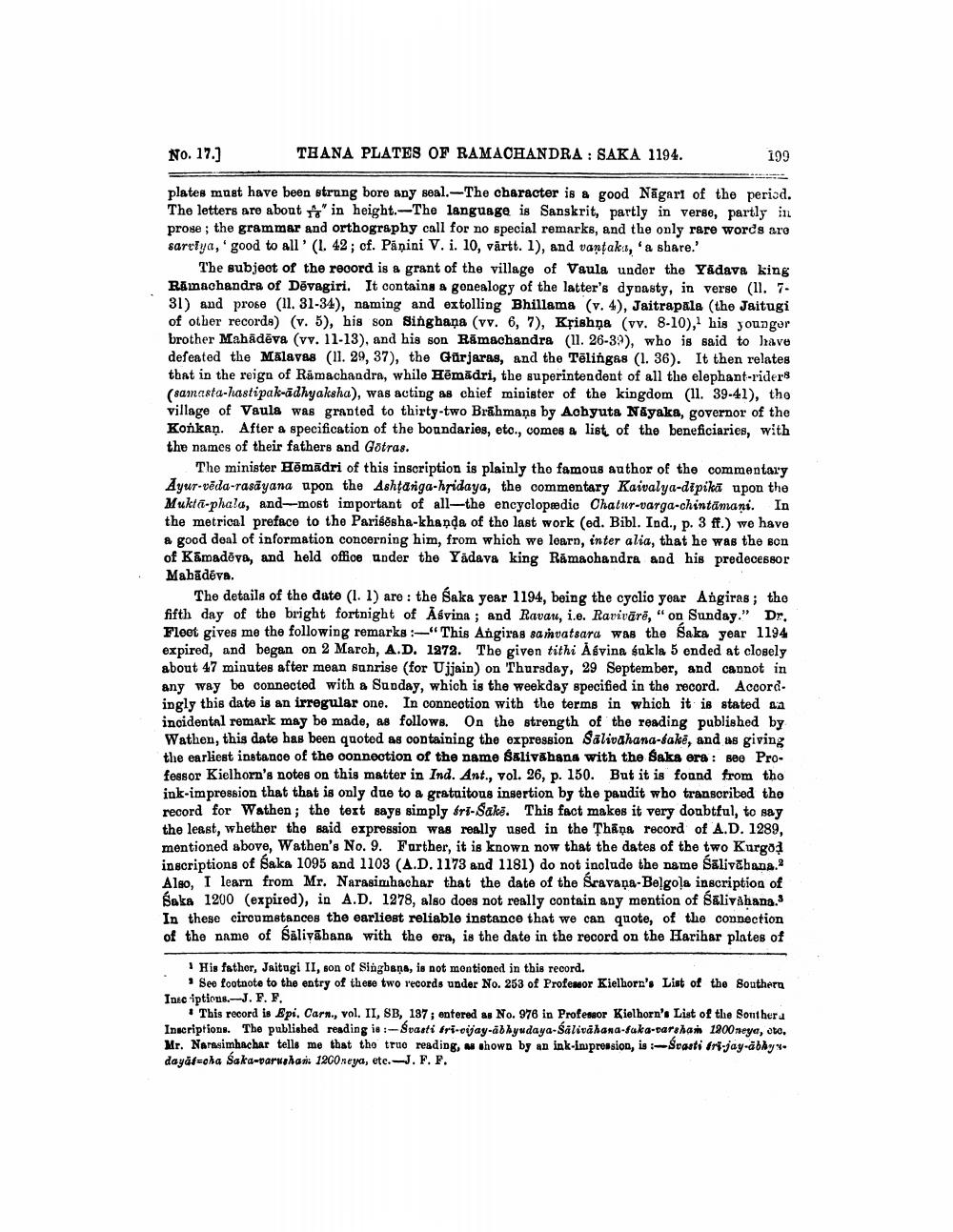________________
No. 17.)
THANA PLATES OF RAMACHANDRA : SAKA 1194.
199
plates must have been strong bore any seal.-The character is a good Nāgari of the period. The letters are about f' in height.-The language is Sanskrit, partly in verse, partly in prose; the grammar and orthography call for no special remarks, and the only rare words are sarriya,' good to all' (1. 42; cf. Pāņini V. i. 10, vārtt. 1), and vantaks, 'a share.'
The subjeot of the record is a grant of the village of Vaula under the Yadava king Ramachandra of Dēvagiri. It contains a genealogy of the latter's dynasty, in verse (11.7. 31) and prose (11. 31-34), naming and extolling Bhillama (v.4), Jaitrapala (the Jaitugi of other records) (v. 5), his son Singhaņa (vv. 6, 7), Kpishņa (vv. 8-10), his younger brother Mahadēva (vv. 11-13), and his son Ramachandra (11. 26-39), who is said to have defeated the Malavas (11. 29, 37), the Gürjaras, and the Tēlingas (1. 36). It then relates that in the reign of Ramachandra, while Hēmādri, the superintendent of all the elephant-riders (samasta-lastipak-adhyaksha), was acting as chief minister of the kingdom (11. 39-41), the village of Vaula was granted to thirty-two Brāhmaṇs by Achyuta NĀyaka, governor of the Konkan. After a specification of the boundaries, eto., comes a list of the beneficiaries, with the names of their fathers and Gotras.
The minister Hēmādri of this inscription is plainly the famous author of the commentary Ayur-vēda-rasāyana upon the Ashtariga-hridaya, the commentary Kaivalya-dipika upon the Muktā-phala, and most important of all-the encyclopædic Chatur-varga-chintamani. In the metrical preface to the Parisēsha-khanda of the last work (ed. Bibl. Ind., p. 3 ff.) we have a good deal of information concerning him, from which we learn, inter alia, that he was the son of Kamadove, and held office under the Yadava king Ramachandra and his predecessor Mahādēva.
The details of the date (1.1) are: the Saka year 1194, being the cyclio year Angiras ; the fifth day of the bright fortnight of Āśvina ; and Ravan, i.e. Ravivārē," on Sunday." Dr. Fleet gives me the following remarks :-"This Angiras samvatsara was the Saka year 1194 expired, and began on 2 March, A.D. 1272. The given tithi Asvina sukla 5 ended at closely about 47 minutes after mean sunrise (for Ujjain) on Thursday, 29 September, and cannot in any way be connected with a Sunday, which is the weekday specified in the record. Accord ingly this date is an irregular one. In conneotion with the terms in which it is stated ea incidental remark may be made, as follows. On the strength of the reading published by Wathen, this date has been quoted as containing the expression Salivahana-fake, and as giving the earliest instance of the connection of the name salivāhana with the Saks era: see Professor Kielhorn's notes on this matter in Ind. Ant., vol. 26, p. 150. But it is found from tho ink-impression that that is only due to a gratuitous insertion by the pandit who transcribed the record for Wathen; the text says simply fri-Sake. This fact makes it very doubtful, to say the least, whether the said expression was really used in the Thiņa record of A.D. 1289, mentioned above, Wathen's No. 9. Further, it is known now that the dates of the two Kurgo? inscriptions of Saka 1095 and 1103 (A.D. 1173 and 1181) do not include the name Sālivahana. Also, I learn from Mr. Narasimhachar that the date of the Sravana-Belgola inscription of Saka 1200 (expired), in A.D. 1278, also does not really contain any mention of Salivahana. In these circumstances the earliest reliable instance that we can quote, of the connection of the name of Salivābana with the era, is the date in the record on the Harihar plates of
His father, Jaitugi II, son of Singbaņa, is not montioned in this record.
See footnote to the entry of these two records under No. 253 of Profesor Kielhorn's List of the Southern Inec ipticus.-J. F.F.
This record is Epi. Carn., vol. II, SB, 137; entered as No. 976 in Professor Kielhorn'. List of the Southera Inscriptions. The published reading is :- Svasti fri-vijay-abhyudaya-Salivahana-faka-Darshan 1200 neya, ate. Mr. Narasimhachar tells me that the true reading, w shown by an ink-in-pronsion, is --Svasti fri-jay-abhy. dayafscha Saka-parushan. 1200 nega, etc.-J. F. P.




